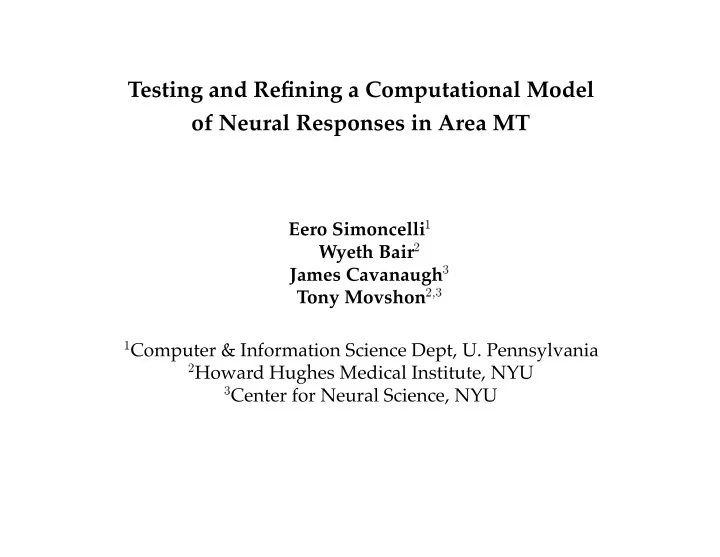

Testing and Re Þ ning a Computational Model of Neural Responses in Area MT Eero Simoncelli � Wyeth Bair � James Cavanaugh � Tony Movshon � � � � Computer & Information Science Dept, U. Pennsylvania � Howard Hughes Medical Institute, NYU � Center for Neural Science, NYU
Stage I: V1 Simple Cells Input: image intensities . . . . . . e-2 • • . . . + . . . � Combines image intensities via space-time oriented linear Þ lters. � Response tuned for spatio-temporal frequency. 5/96 1
MT Component Cell Construction - - + + + - - - - + + + - - - - + + + - - � Linear Combination of V1 Cells tuned for: – range of spatial frequencies / R.F. positions – Þ xed orientation and speed � Recti Þ cation / Normalization
MT Component Cells Input: stage I outputs c . . . • • . . . c-2 • • . . . + . . . � Combines outputs of V1 units tuned for different spatial and tem- poral frequencies, and RF positions. � Response tuned for orientation and speed of 1D patterns (stripes). 5/96 2
MT Pattern Cell Construction s - - + + + - - s + - - + s /2 - - s /2 - + - + - + + + - + - - - + - + + + - + + + s /2 - - s /2 - - - - - � Linear Combination of V1 Cells tuned for: – range of spatial frequencies / R.F. positions – speed/orientationcombinations consistentwith pattern motion � Recti Þ cation / Normalization
MT Pattern Cells Input: V1 outputs v . . . • • . . . v-2 • • . . . + . . . � Combines outputs of V1 units tuned for different orientations, spa- tial/temporal frequencies, and RF positions. � Response tuned for 2D image pattern velocity (speed & direction). 5/96 3
Component vs. Pattern Component Cell Pattern Cell Grating -180 0 180 -180 0 180 Plaid -180 0 180 -180 0 180 Movshon et. al., 1986 5/96 4
Drifting Dot Stimulus � Sum of Gratings s s √ 3 s/2 √ 3 s/2 = + s/2 s/2 5/96 5
Drifting Dot Stimulus � Sum of Grating s t = s * s t -90 -60 -30 0 30 60 90 direction 5/96 6
Component Cell / Drifting Dots slow dots medium dots fast dots speed direction direction direction cell preference stimulus � Prediction: direction-tuning for dots becomes bimodal at high speeds. 5/96 7
Component Cell / Drifting Dots Cell Model 6.5 d/sec 3.25 d/sec speed 1.63 d/sec 0.81 d/sec 0.4 d/sec -180 -120 -60 0 60 120 180 -180 -120 -60 0 60 120 180 direction direction � Bimodality at high speeds (as predicted). � Similar behavior in V1 complex cells (Movshon, et. al., 1980).
Component Cell / Sine Grating Cell Model 3.3 Hz 1.65 Hz 0.83 Hz t 0.41 Hz 0.21 Hz -180 -120 -60 0 60 120 180 -180 -120 -60 0 60 120 180 direction direction � Direction-tuning curves independent of speed.
Pattern Cell / Drifting Dots Cell Model 6.5 d/sec 3.25 d/sec 1.63 d/sec speed 0.81 d/sec 0.4 d/sec -180 -120 -60 0 60 120 180 -180 -120 -60 0 60 120 180 direction direction � Direction-tuning curves independent of speed.
Pattern Cell / Sine Grating Cell Model 6.6 Hz 1.65 Hz t 0.83 Hz 0.41 Hz 0.21 Hz -180 -120 -60 0 60 120 180 -180 -120 -60 0 60 120 180 direction direction � Bimodality at low speeds (as predicted). � Bimodality not foundforsingledriftingbars(Rod- man & Albright, 1987).
Conclusions Stimulus n Cell Type Component Pattern Grating Unimodal Bimodal @ low speeds Dots Bimodal @ high speeds Unimodal 5/96 8
Recommend
More recommend